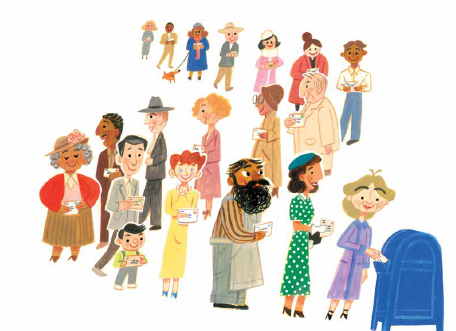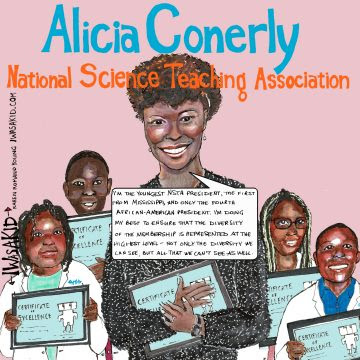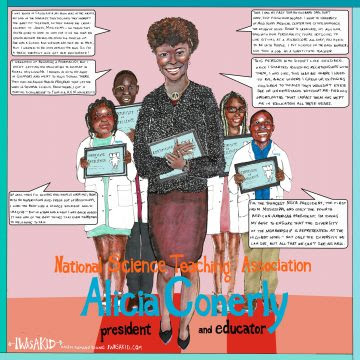 Welcome to STEM Tuesday: Author Interview, a repeating feature for the last Tuesday of every month. Go Science-Tech-Engineering-Math!
Welcome to STEM Tuesday: Author Interview, a repeating feature for the last Tuesday of every month. Go Science-Tech-Engineering-Math!
Why are author interviews such an important part of STEM Tuesday? For one, it’s fun for kids (and adults!) to read about doing research and writing from the person doing the work. Plus, getting a glimpse into what it’s like to be an author can get kids (again – and adults!) excited about doing their own writing!
Without further ado, let’s meet Lori Alexander, who lives in Arizona and is the award-winning author of several kids’ books. Her most recent book is DESERT QUEEN, which is all about Minerva Hoyt and her advocacy and passion for the desert. Here’s more about the book:
“Long before she became known as the Cactus Queen, Minerva Hamilton Hoyt found solace in the unexpected beauty of the Mojave Desert in California. She loved the jackrabbits and coyotes, the prickly cacti, and especially the weird, spiky Joshua trees.
However, in the 1920s, hardly anyone else felt the same way. The desert was being thoughtlessly destroyed by anyone and everyone. Minerva knew she needed to bring attention to the problem. With the help of her gardening club, taxidermists, and friends, she worked to persuade politicians, scientists, teachers, and others to support her cause. And, it worked! Minerva’s efforts led to what came to be known as Joshua Tree National Park in California, and saved hundreds of thousands of plants and animals.”
Andi Diehn: What’s your favorite fact you learned about Minerva Hoyt?
Lori Alexander: I love that Minerva’s path to protect the Mojave desert took many twists and turns. It’s not easy to speak up for change, especially as a woman in the early 1900s. In addition to transporting bits of the desert to the east coast to rally support for her cause, Minerva started a letter writing campaign and even pitched her idea to turn the Joshua tree area of the Mojave into a national park to the president of the United States. My favorite fact was that Minerva made two scrap books to take to the White House. They were packed with beautiful photographs and artwork of the Mojave desert which helped to make her case to President Franklin D. Roosevelt. In 2021, I took a research trip to Joshua Tree National Park and met with the park’s archivist. I was allowed to (carefully) flip through the very same albums Minerva shared with the president in 1933!
 Lori: My first nonfiction editor, Ann Rider, now retired, taught me that quotes from historical figures “bring the text to life.” They were sprinkled throughout our books together: All in a Drop and A Sporting Chance and What’s a Germ, Joseph Lister? While I’m working with different editors and publishers now, I continued to include rich quotes throughout my texts, pulled from primary sources such as letters, interviews, and scientific papers. Cactus Queen begins with these words from Minerva: “This desert possessed me, and I constantly wished that I might find some way to preserve its natural beauty.” A great quote, as it also sets-up the story problem and Minerva’s motivation.
Lori: My first nonfiction editor, Ann Rider, now retired, taught me that quotes from historical figures “bring the text to life.” They were sprinkled throughout our books together: All in a Drop and A Sporting Chance and What’s a Germ, Joseph Lister? While I’m working with different editors and publishers now, I continued to include rich quotes throughout my texts, pulled from primary sources such as letters, interviews, and scientific papers. Cactus Queen begins with these words from Minerva: “This desert possessed me, and I constantly wished that I might find some way to preserve its natural beauty.” A great quote, as it also sets-up the story problem and Minerva’s motivation.
AD: Minerva moves plants native to the west to the east – yet the book is about preserving the native plants in the desert. How is this action considered part of conservancy?
Lori: Minerva transported bits of the desert vegetation, as well as rocks, sand, and taxidermy desert animals, to New York and Boston for their annual flower shows. She set up displays about the size of a classroom to share the beauty of the Mojave. Audiences were captivated, as most had never seen such a landscape before. Minerva believed this was an important step in gaining support for her cause. If people loved the desert, they would want to protect the desert. After the flower shows ended, she donated the displays to local museums so people could continue learning about the desert. Her main goal was to show that the desert is not a barren wasteland, but a beautiful place filled with unique plants and animals worth saving.
AD: The problem of people claiming wild plants as their own and removing them from their native habitat – where can we find examples of this today? What’s being done to fix this?
 Lori: I currently live in a desert not far from the Mojave—the Sonoran desert in Arizona. Much as Joshua trees represent the Mojave, the Sonoran desert is known for its towering saguaro cacti. Saguaros can grow to 50 feet tall and live more than 150 years. They are a slow growing cacti, with only a few inches of growth during their first ten years. It can take more than 60 years for a saguaro to grow its first arm. While many people here in Tucson would love to have one of these stately, iconic cacti in their front yard, it is illegal to poach them from the desert floor. Luckily, state-wide laws protect saguaro from theft, vandalism, and unnecessary destruction. If a saguaro interferes with new construction projects, permits are required to move and replant the specimen. Because of such laws, saguaros are highly safeguarded and not currently listed as threatened or endangered, although they may soon face other challenges due to climate change.
Lori: I currently live in a desert not far from the Mojave—the Sonoran desert in Arizona. Much as Joshua trees represent the Mojave, the Sonoran desert is known for its towering saguaro cacti. Saguaros can grow to 50 feet tall and live more than 150 years. They are a slow growing cacti, with only a few inches of growth during their first ten years. It can take more than 60 years for a saguaro to grow its first arm. While many people here in Tucson would love to have one of these stately, iconic cacti in their front yard, it is illegal to poach them from the desert floor. Luckily, state-wide laws protect saguaro from theft, vandalism, and unnecessary destruction. If a saguaro interferes with new construction projects, permits are required to move and replant the specimen. Because of such laws, saguaros are highly safeguarded and not currently listed as threatened or endangered, although they may soon face other challenges due to climate change.
AD: I love the part about the letter writing campaign! What can children learn from this? 
Lori: Minerva hosted an inspection over acres of the Mojave—the last step before the space could be named a national park. But the appointed government official wondered where the lush trees and roaring waterfalls could be found. He reported that the area was not fit for protecting under federal law. After the failed inspection, Minerva began a letter writing campaign. She want the National Park Service (NPS) to send a new inspector, someone who better understood desert landscapes. She called on her friends and neighbors, local scientists, teachers and politicians. They wrote letters to the NPS for five months until a new inspection was scheduled. A second chance for the desert! From this, children can learn that they too have a voice, and that there is power in numbers. If there’s something they want to change in their school, neighborhood, city, or the greater world, they can speak up. Elementary-age kids have families and a network of classmates, teachers, and neighbors who may be willing to help make change. It could begin with something as simple as writing a letter (or email) to a local elected official.
AD: Why are national parks so important to wildlife conservancy?
Lori: They are crucial! In addition to preserving landscapes and protecting ecological biodiversity, national parks inspire wonder and life-long learning by those who visit. The NPS estimates that 325 million people visited the national park system in 2023, which includes 63 national parks and more than 350 historic sites managed by the NPS. These unique places help to educate the public on the importance of conservation. I always feel a bit more connected to the planet after a stay at one of these stunning spots and I encourage you to get out there and explore. Here’s a list of all of the sites managed by the NPS and their rates of attendance over the past ten years. Whether you visit one of the most popular parks or a lesser-known gem, be sure to leave no trace of your stay.
AD: In your author’s note you talk about damage done to the park during a government shutdown. That’s horrifying! Why do you think people hurt the environment so deliberately?
Lori: I’m guessing many people don’t think, and that’s the problem. They’ve traveled a distance to be there and feel entitled to the space. In 2019, during a 35-day government shut-down, Joshua Tree National Park remained open but with a very limited staff to manage the park’s 1200 square miles. Visitors began to ignore the rules. They squabbled over camp sites, scattered garbage, clogged toilets, and spray-painted boulders. They hung holiday lights around delicate Joshua tree branches. Other plants were cut down to make paths for racing off-road vehicles. The destruction took place over just a few days, but scientists estimate it could take up to 200 years for the slow-growing Joshua trees to recover. So while federal laws protect these beautiful spaces, it’s up to all of us to follow the rules and continue to speak up to defend these areas.
AD: Jenn Ely’s illustrations are fantastic – and I love the wildlife on every page. How do beautiful, accurate illustrations enhance a nonfiction picture book?
Lori: As I mentioned earlier about historical quotes bringing a story to life, the same is true for illustrations. Jenn’s artwork is lovely! Many people think “dry wasteland” when they hear the word desert. But Jenn created such a vibrant scene of the Mojave’s varied plants and animals. I adore every page but especially the nighttime spread, where Minerva camps out with the Joshua trees, and the final spread, when Minerva wins her hard-fought battle to protect the region she loved so much.

Bio:
 In addition to picture books, LORI ALEXANDER writes chapter books about the fascinating history of science and medicine. She won a Sibert Honor Award for All in a Drop: How Antony van Leeuwenhoek Discovered an Invisible World, and A Sporting Chance: How Ludwig Guttmann Created the Paralympic Games was named a Kirkus Reviews Best Book. Her recent release, What’s a Germ, Joseph Lister?: The Medical Mystery That Forever Changed the Way We Heal, is a Junior Library Guild Gold Standard Selection. Lori resides in Tucson, Arizona, with her scientist husband and two book-loving teens. lorialexanderbooks.com
In addition to picture books, LORI ALEXANDER writes chapter books about the fascinating history of science and medicine. She won a Sibert Honor Award for All in a Drop: How Antony van Leeuwenhoek Discovered an Invisible World, and A Sporting Chance: How Ludwig Guttmann Created the Paralympic Games was named a Kirkus Reviews Best Book. Her recent release, What’s a Germ, Joseph Lister?: The Medical Mystery That Forever Changed the Way We Heal, is a Junior Library Guild Gold Standard Selection. Lori resides in Tucson, Arizona, with her scientist husband and two book-loving teens. lorialexanderbooks.com
Lori occasionally posts to IG: @lorialexanderbooks or Twitter: @LoriJAlexander
Peek into or purchase CACTUS QUEEN here.



